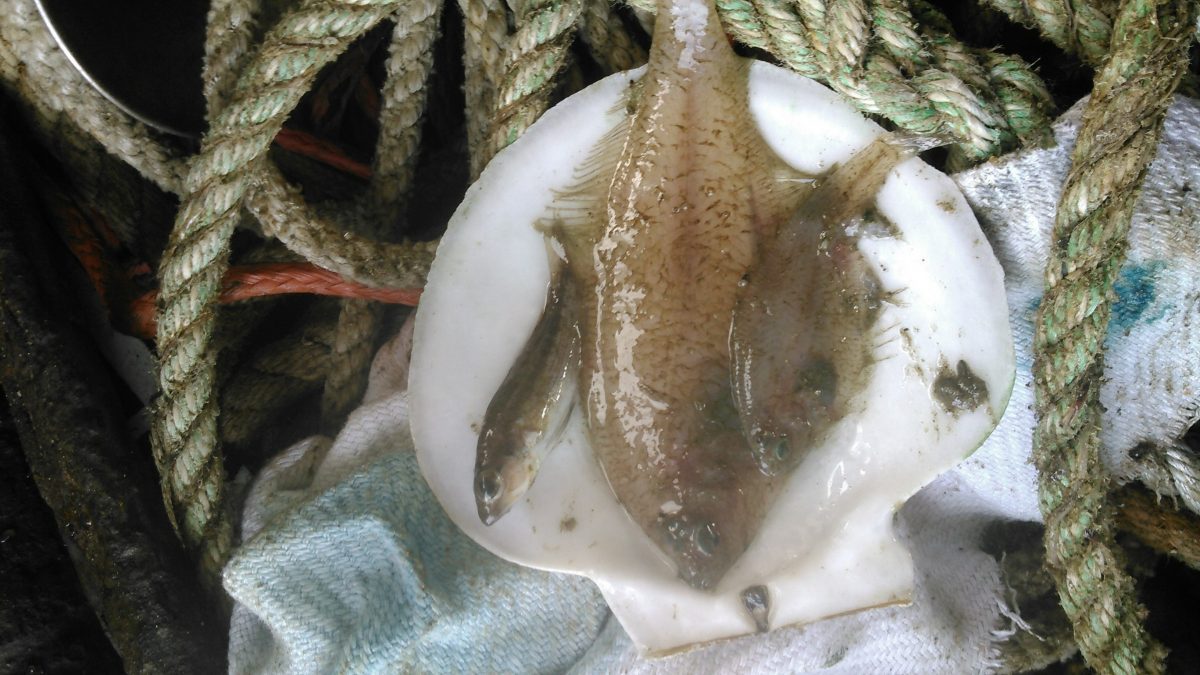Tropical fish…up north? How ocean physics play a role in altering water temperature and salinity
 Gulf Stream flounder and Black Sea bass caught near Block Island, RI. An unusual catch, but the reason it was found so far up north is likely due to a warm water intrustion caused by ocean eddies and wind, explained in a new WHOI-led study.
Image credit: Mike Marchetti (inshore scallop fisherman)
Gulf Stream flounder and Black Sea bass caught near Block Island, RI. An unusual catch, but the reason it was found so far up north is likely due to a warm water intrustion caused by ocean eddies and wind, explained in a new WHOI-led study.
Image credit: Mike Marchetti (inshore scallop fisherman) December 10, 2021
Woods Hole, MA — A study led by Woods Hole Oceanographic Institution scientists is explaining why warm and salty water along with warm water fish species, such as the deep-sea dwelling Gulf Stream flounder and Black Sea bass, were found far inshore in New England in the middle of winter 2017. How did this happen? Researchers say it is due to an intrusion of offshore water from the open ocean onto the Northeast U.S. Shelf, caused by eddies (a circular current of water) and wind. The findings were published this week in a paper co-authored by WHOI physical oceanographers Ke Chen, Glen Gawarkiewicz , and Jiayan Yang, published in the Journal of Geophysical Research: Oceans.
Using data collected by the commercial fishing industry, observations from Ocean Observatories Initiative’s Coastal Pioneer Array, and a new high-resolution computer model, the authors found that offshore activity by eddies and upwelling wind work jointly to produce an intrusion of warm salty offshore water to the inner shelf. The cyclonic eddies near the shelf break create pressure gradients and provide favorable conditions for the intensification of the shelf break front, both processes driving intrusions of high-temperature, high-salinity offshore water onto the outer continental shelf. Subsequently, strong upwelling winds drove a rapid, bottom-intensified penetration composed of the unusual water mass from the cyclonic eddies. The results of this study highlight the importance of smaller scale cyclonic eddies and the intricacy of the relationship between multiple processes to drive significant ocean-altering events.
This study provides an improved understanding of mechanisms connecting the large-scale processes in the open ocean and variability in the coastal region. This work also explains the unusual catch of Gulf Stream warm water species in shallow regions near Block Island, RI.
About Woods Hole Oceanographic Institution
The Woods Hole Oceanographic Institution (WHOI) is a private, non-profit organization on Cape Cod, Massachusetts, dedicated to marine research, engineering, and higher education. Established in 1930, its primary mission is to understand the ocean and its interaction with the Earth as a whole, and to communicate an understanding of the ocean’s role in the changing global environment. WHOI’s pioneering discoveries stem from an ideal combination of science and engineering—one that has made it one of the most trusted and technically advanced leaders in basic and applied ocean research and exploration anywhere. WHOI is known for its multidisciplinary approach, superior ship operations, and unparalleled deep-sea robotics capabilities. We play a leading role in ocean observation and operate the most extensive suite of data-gathering platforms in the world. Top scientists, engineers, and students collaborate on more than 800 concurrent projects worldwide—both above and below the waves—pushing the boundaries of knowledge and possibility. For more information, please visit www.whoi.edu.
